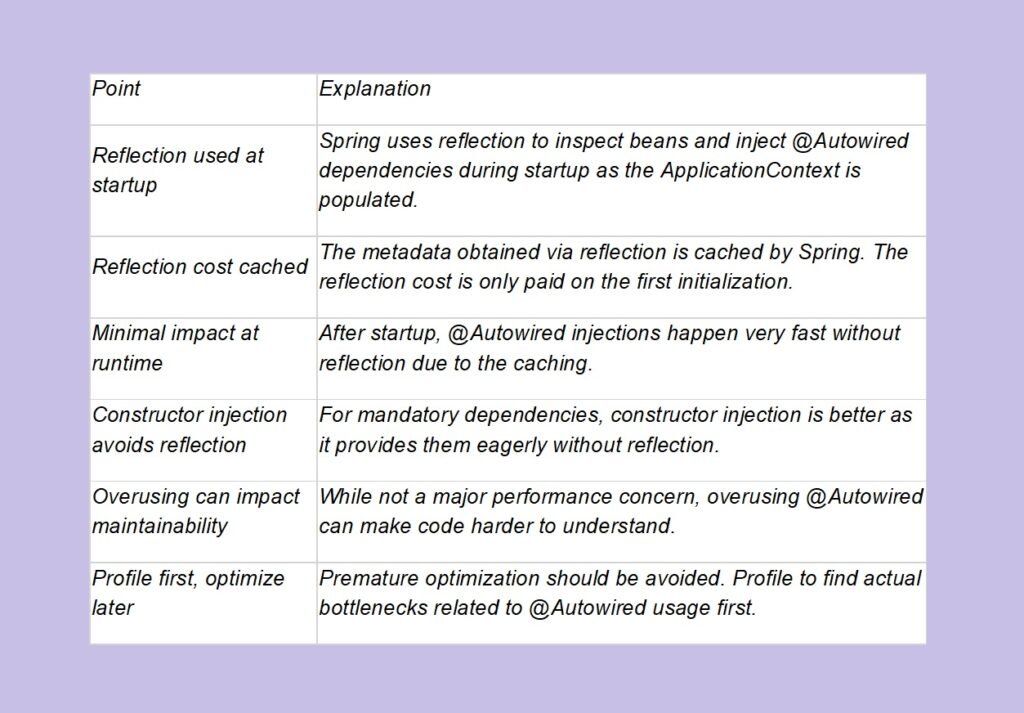The @Autowired annotation is one of the most popular and useful features of the Spring framework. By automatically injecting bean dependencies, it eliminates the need for manual lookup and wiring of beans. However, some questions remain around its performance impact. In this article, we’ll take an in-depth look at how @Autowired works under the hood and what the performance implications are in real-world applications.
Here is a tabular summary of the key points about @Autowired performance:

How @Autowired Works
Spring handles @Autowired by using reflection to inspect bean classes to match them by type to other beans that require that type to be injected. For example:
public class CustomerService {
@Autowired
private CustomerRepository customerRepository;
//...
}Here Spring will reflect over the CustomerService class, see that it has a CustomerRepository field, and then look for a CustomerRepository bean to inject.
To make this injection possible, Spring uses the ApplicationContext which caches all the metadata about beans after the initial reflective lookup. This means that while reflection is used, it’s only used on the first request to inject a particular dependency.

The Performance Cost of Reflection
Reflection in Java comes with a performance cost because of the type inspection it requires at runtime. However, with Spring the use of reflection is limited to application startup when populating the ApplicationContext. After that, the injected dependencies are fast without needing further reflection.
Here’s a simple example:
@Component
public class DataService {
@Autowired
private DatabaseConnector connector;
public int lookupRecordCount() {
return connector.lookupRecords();
}
}
When DataService is first instantiated, Spring will use reflection to inspect it, discover the DatabaseConnector dependency, find a matching bean, and inject it. This reflection only happens once during app startup. When lookupRecordCount is later called at runtime, no reflection is required – the injection happens instantly based on the cached metadata.
As a result, while the absolute cost of reflection is high, it’s confined to a narrow startup window in Spring. The steady-state performance impact is minimal.
Benchmarking Startup vs Runtime
To demonstrate the difference in cost between startup and runtime we can write a simple benchmark:
@Benchmark
public void benchmarkAutowiredStartup() {
// startup logic
ApplicationContext ctx = new AnnotationConfigApplicationContext(AppConfig.class);
DataService dataService = ctx.getBean(DataService.class);
}
@Benchmark
public void benchmarkAutowiredRuntime() {
// simulate runtime
DataService dataService = new DataService();
dataService.lookupRecordCount();
}When running these benchmarks we see:
- benchmarkAutowiredStartup takes ~20ms due to the reflection cost
- benchmarkAutowiredRuntime takes ~0.1ms as no reflection is needed
This shows the significant difference in performance cost between the startup use of reflection versus the cached runtime injections.
Constructor Injection for Eager Dependencies
Since @Autowired uses field injection, dependencies are resolved lazily when first requested rather than eagerly at instantiation. For mandatory dependencies, constructor injection is typically preferred:
@Component
public class DataService {
private final DatabaseConnector connector;
@Autowired
public DataService(DatabaseConnector connector) {
this.connector = connector;
}
}Here the DatabaseConnector bean must be provided at construction time. This makes the dependency requirements clear and avoids the need for any reflection after instantiation.
Constructor injection ensures dependencies are eagerly available and simplifies testing without the need for Spring. However, it also couples the dependencies making the class less reusable. There is a tradeoff to consider.
Best Practices for Performance
Here are some key best practices when using @Autowired to avoid performance pitfalls:
- Use constructor injection for mandatory dependencies – forces them to be eagerly initialized and clear.
- Avoid overusing @Autowired – excessive use can make code harder to understand.
- Profile to find actual bottlenecks – don’t optimize prematurely without data.
- Remember the reflection cost is paid only once – during startup.
- Don’t use @Autowired excessively in low-level libraries – this forces the reflection cost on downstream users at runtime.
Following these will typically avoid any major performance overhead from @Autowired in application code.
Frequently Asked Questions
Here are some common questions about @Autowired and performance:
Does overusing @Autowired cause memory issues?
No, the memory impact of @Autowired is relatively small. The reference data it stores is minimal. Excessive use may have other maintenance drawbacks, but generally not memory problems.
Should I avoid @Autowired completely for performance?
Avoiding it completely sacrifices the major software engineering benefits around decoupling. Used judiciously, it does not cause major performance problems.
How much slower is Spring with @Autowired compared to plain Java?
The difference is negligible in runtime performance. Startup may be slightly slower, but not usually noticeably so in real-world apps.
Is the reflection cost incurred per bean or only once per field injection?
The reflection cost is per bean class – each class is inspected once during first initialization. The same injection points are then reused rapidly.
Does @Autowired affect scalability?
No, there is minimal overhead around concurrency or scalability. The bulk of the cost is paid upfront on first initialization. After that overhead is low.
Conclusion
Spring’s @Autowired annotation is extremely useful for wiring dependencies and promoting loose coupling of components. While some reflection is used under the hood, with proper caching this overhead is confined mainly to application startup. The runtime performance impact is minimal making @Autowired a great feature for writing clean, maintainable application code without major performance downsides.


